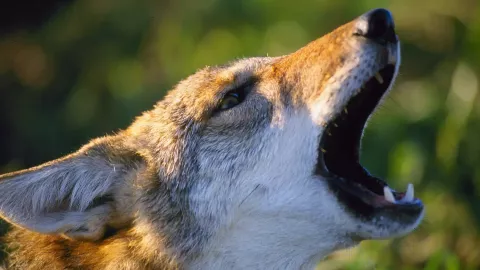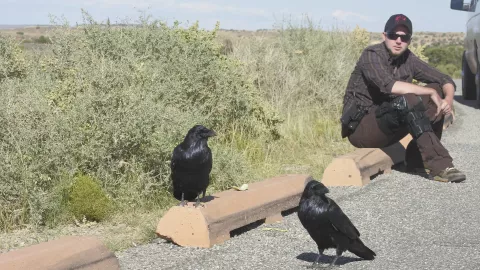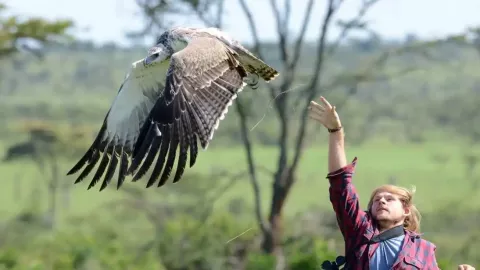Wildlife Ecology and Conservation Biology
Wildlife Ecology and Conservation Biology
Ecology and Population Dynamics of Elk in Fragmented Forests of Appalachia

A McIntire-Stennis supported project
Elk were common to the eastern U.S. prior to 1800, but hunting and other pressures caused their demise. There is now significant interest and activity in reintroducing elk to many states to provide recreational and economic opportunities and return an important species to the ecosystem. In the absence of large predators like the gray wolf, rapid population growth of elk in states like Kentucky have posed challenges to management of this wide-ranging species, particularly where high population densities occur. Populations must be managed to ensure that recreation and economic opportunities are sustained while minimizing negative impacts to the environment and humans.
McIntire-Stennis supported research at the University of Kentucky Department of Forestry and Natural Resources aims to quantify important aspects of reintroduced elk populations that are important in managing the species in the Appalachian region. Research is also characterizing the ecological impacts of elk including the browsing of tree seedlings that impedes the regeneration of native forests and reclaimed surface mines, spread of invasive species, and human-elk interactions.
Collaboration
Researchers have worked in partnership with Kentucky Department of Fish and Wildlife Resources, Morehead State University, University of Tennessee, USDA Animal Parasitic Diseases Laboratory, and the Rocky Mountain Elk Foundation to advance elk reintroductions and population management.
Impact
20 years of research continues to inform management of elk in Kentucky and characterize important ecological impacts of this large herbivore on forest communities and reforestation sites.
$1.5 million
in competitive grant funds for elk research in Kentucky.
22 and 400
graduate students with published science and undergraduate students involved in elk research and education.
1 and 3.5 million
annual economic contribution of elk hunting in Kentucky and the number of acres in Appalachia that this on-going research impacts.
Ecology and Conservation of Forest-Dwelling North American Bats

A McIntire-Stennis supported project
Threatened and endangered species, including a number of forest dwelling bats, are an important ecological concern and also pose challenges for forest operations throughout the US, potentially impacting economically feasible access to billions of dollars in timber assets. Bats are experiencing significant declines from disease, climate change, pesticides, wind power development, and a host of changes to our forested landscapes. McIntire-Stennis supported research at the University of Kentucky Department of Forestry and Natural Resources has focused on management of forested landscapes for bats, addressing timber extraction, prescribed fire, and impacts from white-nose syndrome, a disease specific to populations of bats in Kentucky and the eastern US.
Research efforts have been directed at understanding specific dietary, roosting, and foraging requirements of bats, and how these needs are influenced by changes in land use practices. The goal of this research is to educate management efforts for imperiled bat species by providing a better understanding of the ecology and habitat requirements of these bats and how they are likely to be affected by proposed and existing forest management policies.
Collaboration
Researchers at the University of Kentucky are working in partnership with US Fish and Wildlife Service, US Forest Service, National Park Service, Bureau of Land Management, Kentucky Department of Fish and Wildlife Resources, Kentucky Nature Preserves, and Industry TIMOs.
Impact
Understanding the biology and requirements of imperiled bat species along with their response to forest use and change allows us to develop better management strategies and help inform policies that can aid in benefiting these species and help ensure continued conservation and use of our forests.
68 and 100+
students, undergraduate and graduate, trained and scientific publications generated from this on-going research.
13 Million
acres of forest lands spanning 8 states in eastern, Midwestern and northwestern US, have instituted management changes to improve bat habitat.
About McIntire-Stennis
The McIntire-Stennis program, a unique federal-state partnership, cultivates and delivers forestry and natural resource innovations for a better future. By advancing research and education that increases the understanding of emerging challenges and fosters the development of relevant solutions, the McIntire-Stennis program has ensured healthy resilient forests and communities and an exceptional natural resources workforce since 1962.
Additional Research

Impacts of snake fungal disease on wild snake populations
Snake fungal disease is an emerging threat to snake populations in the Commonwealth and throughout the eastern US. Infected snakes often have skin ulcers, facial swelling, unusual molting and aberrant behaviors. Over the last three years, the Price lab has developed unique field and molecular techniques and innovative statistical tools for analysis of SFD impacts in wild snake populations. Our research objectives include 1) Determine disease-associated rates of true survival in snake populations and 2) Identify factors influencing disease susceptibility. We focus our research on queen snakes and northern water snakes, common stream-associated species in the inner bluegrass region of Kentucky.

Salamander population dynamics in relation to land-use in Eastern Kentucky
Human-induced, land-use changes are among the primary causes of ecosystem degradation and biodiversity loss. Across central Appalachia, land-use change represents a stressor to stream ecosystems. Salamanders are the dominant vertebrate in Appalachian headwater streams. Thus, we address basic questions, including: 1) Do population and community dynamics vary across landscapes with different land uses? How do physical and chemical properties of streams correlate with land use? Our primary goal is to provide effective management strategies for amphibians and the streams and landscapes they inhabit.

Using Landscape Genetics to Investigate Red Wolf-Coyote Hybridization and Coyote Colonization of Kentucky
The red wolf is a critically endangered canid species that numbers < 100 individuals in the wild. In contrast, the coyote has rapidly expanded its range and population size to include all the lower 48 states. Small population size of red wolves has led to extensive hybridization between red wolves and coyotes over the past 50 years, making species recovery of red wolves problematic. In partnership with Louisiana Fish and Game and the U.S. Fish and Wildlife Service, we assess the level of genetic introgression of red wolf genes into the coyote population of the southeastern U.S. We also examine statewide genetic characteristics of coyotes in Kentucky including potential colonization paths into the state. This project is led by M.S. forestry grad student Stratton Hatfield.

Detecting the (Not-so) Common Raven in Kentucky
The common raven (Corvus corax) is a cliff-nesting bird species of concern and state listed as threatened in Kentucky. Suitable breeding habitat appears to be extensive in Kentucky but the status of this species in cliff habitat is largely unknown. We characterized the detectability and nesting sites of the common raven in cliff habitat and developed protocols for monitoring the species in key habitat in eastern portions of the Commonwealth. This project is led by M.S. Forestry grad student Josh Felch.

Demographic and Genetic Characteristics of a Recolonizing Black Bear Population in Eastern Kentucky
Black bears are thought to have become extinct in Kentucky before 1900 as a result of overhunting and forest loss. Bears began a steady recolonization of the state from neighboring WV and VA in the late 1990’s, with relative bear numbers highest in the southeastern counties. As bear numbers have grown, so have complaints of human-bear conflict, and interest in hunting the species. Our research led by doctoral student Sean Murphy in conjunction with KDFWR uses a combination of live capture and non-invasive hair snares to estimate regional population size and characterize demographics (e.g. male:female ratio) so as to inform state wildlife managers tasked with management of this species.

The Ecology of the Martial Eagle in the Maasai Mara Region of Southern Kenya
Apex (top) predators are critical components of ecosystems, the loss of which can result in a domino (trophic cascade) effect that impacts entire areas and food webs. The Martial Eagle is the largest species of eagle in Africa but its population is declining, with very little known about the species. The Maasai Mara ecosystem in Southern Kenya is a conservation area that has a significant, but largely unknown population of Martial Eagles. In partnership with the Peregrine Fund of East Africa (and Dr. Munir Verani and Dr. Ralph Buij), we will assess the species’ diet, estimate its home range size and characterize nest locations to inform this species’ management and conservation. This project is led by M.S. forestry grad student Stratton Hatfield.
Associated Faculty
Research Topic Areas
Forestry and Natural Resources Department
forestry.department@uky.edu
(859) 257-7596
Forestry and Natural Resources Extension
forestry.extension@uky.edu
(859) 257-7597
